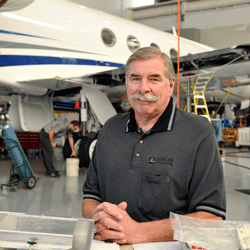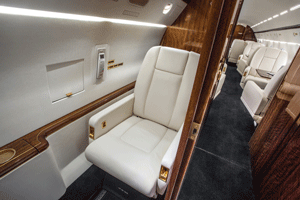 Tim Garity, a longtime Tech Rep with Duncan Aviation, loves aviation, but he also enjoys the people he has met along the way.
Tim Garity, a longtime Tech Rep with Duncan Aviation, loves aviation, but he also enjoys the people he has met along the way.
Like many 18-year-olds, he joined the military so he could see the world. Originally from Erie, Pennsylvania, Tim was thrilled to be stationed on a naval aviation base in Hawaii and rotate from there to bases in Thailand, the Philippines and Japan. His stint in the Navy did more than offer travel opportunities; through it, he found his calling in life.
In 1977, Tim began working in the business aviation industry. In the intervening years, industry changes have been numerous and momentous, and he has enjoyed being on the forefront of aviation technology and mechanics.
However, what he values most are the ongoing, long-term relationships he’s established with Duncan Aviation customers over the years – particularly those who own Astra aircraft.
“I’ve enjoyed working on the Astra because I know the aircraft pretty well, and I’ve always thought the Astra is a well-built, easily maintained plane,” says Tim.
Tim first learned about the Astra in 1985, the year they were type-certificated. And in his Tech Rep position at Duncan Aviation, he began working on the newly certified Israel Aircraft Industries’ Astra in 1986.
“Astras have a niche in the industry where the pilots and mechanics both really like the aircraft,” says Tim. “Owners who have bought one tend to buy them again and again.”
It’s All About Relationships
Phil Carrell, Director of Maintenance at Cin-Air, shares Tim’s long history with the Astra. Phil went to A&P school at the Somerset State Vocational Tech school in Somerset, Kentucky, and the opportunity for hands-on experience is what drew him to aviation in the first place.
“When I was growing up in Bloomington, Indiana, my next door neighbor built airplanes in his garage,” says Phil. “It intrigued me that someone could build an airplane out of nothing.”
In the late 1980s, Cin-Air managed a fleet that included a Citation II, a Westwind and a King Air, and looking to replace the Westwind, Phil’s boss began researching the Astra. They had worked with Duncan Aviation in the past, so when they decided to add to their fleet, they contacted Rene Cardona, a member of Duncan Aviation’s Aircraft Sales and Acquisition team.
“We had worked with Rene in the past and trusted his recommendations,” says Phil. “Our boss believed that the Astra would be a good fit for our company, and when Rene confirmed it, we decided to fly over to the UK and take a look at one.”
In 1990, Phil and Tim traveled to Manchester, England, to look at an Astra SP. Based on that assessment and the market information Rene had provided them, Cin-Air bought the Astra.
Extending the Family
“We liked the economics of the Astra and appreciated its operational capabilities; it was a high-speed, long-range aircraft with a stand-up cabin, and it had all of the latest comforts,” says Phil. “The Astra was a great airplane, and I loved to fly it. It was reliable, and I got to know it well over the years.”
In 2000, Cin-Air added another SP to its fleet because they were so pleased with the aircraft’s reliability. Cin-Air kept the first Astra SP for about 14 years, and in 2004, traded it in for an SPX. Last year, they traded both Astra aircraft for a G200.
“We like the G200 quite well; it was the second in our fleet,” says Phil. “We got our first G200 brand new in 2006. Because we know and like this airplane, and it’s in the same family of aircraft, we bought a third, so now our fleet consists of three G200s.”
Despite changing the composition of the fleet, one thing has remained fairly constant in the last two and a half decades: Cin-Air has turned to Duncan Aviation to service its fleet and provide sales assistance on many occasions.
“When we need refurbishments or paint, I always call Tim Klenke,” says Phil. “My company and I have always valued our relationship with Duncan Aviation because of the honesty and integrity of everyone at the company. Honesty is paramount in our business. We will absolutely continue to do business with Duncan Aviation, and we’ve started taking our aircraft to the Battle Creek, Michigan, facility because it’s so much closer for us.”
 Duncan Aviation Lead Designer Rachael Weverka redesigned the interior for the Gulfstream, proposing an updated color scheme, all new soft goods (fabrics, seat upholstery, headliner fabrics) in the cabin and a unique combination of natural veneers and colored accents.
Duncan Aviation Lead Designer Rachael Weverka redesigned the interior for the Gulfstream, proposing an updated color scheme, all new soft goods (fabrics, seat upholstery, headliner fabrics) in the cabin and a unique combination of natural veneers and colored accents.-1.jpg?width=603&height=402&name=GVSP-N755VE-037%20(Small)-1.jpg) “Now, owners want their interiors to reflect their personalities,” says Rachael. “The custom designs involve colors, fabrics, and textures we haven’t often used in aircraft interiors. It’s been fun to be part of this shift.”
“Now, owners want their interiors to reflect their personalities,” says Rachael. “The custom designs involve colors, fabrics, and textures we haven’t often used in aircraft interiors. It’s been fun to be part of this shift.”


.jpg?width=300&name=N755VE0003%20(Small).jpg)
.jpg?width=300&name=GVSP-N755VE-037%20(Small).jpg) Before & After
Before & After In March 2015, Gulfstream Aerospace Corporation named family owned Duncan Aviation as a Gulfstream authorized warranty facility. Duncan Aviation is the only Gulfstream authorized warranty facility in the United States, and this news thrilled many Duncan Aviation customers who had been asking us to look at adding these capabilities.
In March 2015, Gulfstream Aerospace Corporation named family owned Duncan Aviation as a Gulfstream authorized warranty facility. Duncan Aviation is the only Gulfstream authorized warranty facility in the United States, and this news thrilled many Duncan Aviation customers who had been asking us to look at adding these capabilities. “There is no question this is an exciting opportunity for us,” says Tech Rep Tim Garity. “And the nice thing is we’re already familiar with these models. We’ve been married to the G100/Astra for the last 30 years. It’s a really unique aircraft, with quite a devoted following. Mechanics love to work on them because they’re easy to maintain and the parts are accessible. And pilots love to fly them."
“There is no question this is an exciting opportunity for us,” says Tech Rep Tim Garity. “And the nice thing is we’re already familiar with these models. We’ve been married to the G100/Astra for the last 30 years. It’s a really unique aircraft, with quite a devoted following. Mechanics love to work on them because they’re easy to maintain and the parts are accessible. And pilots love to fly them."





